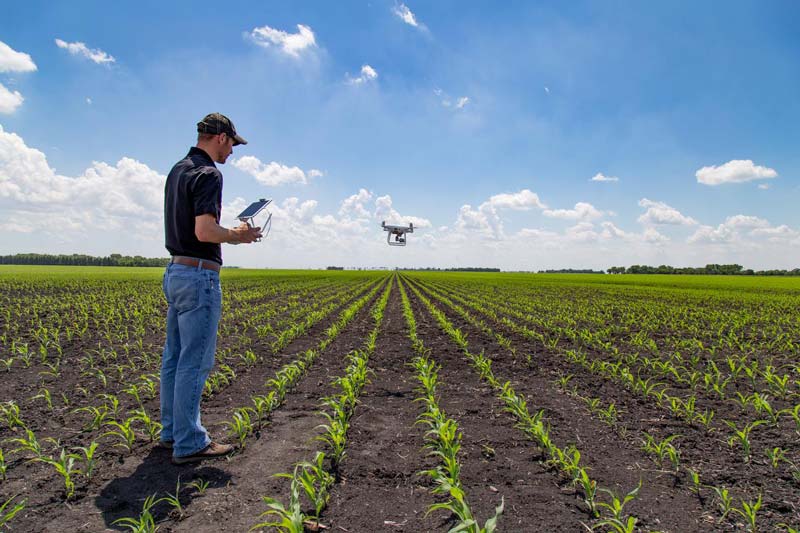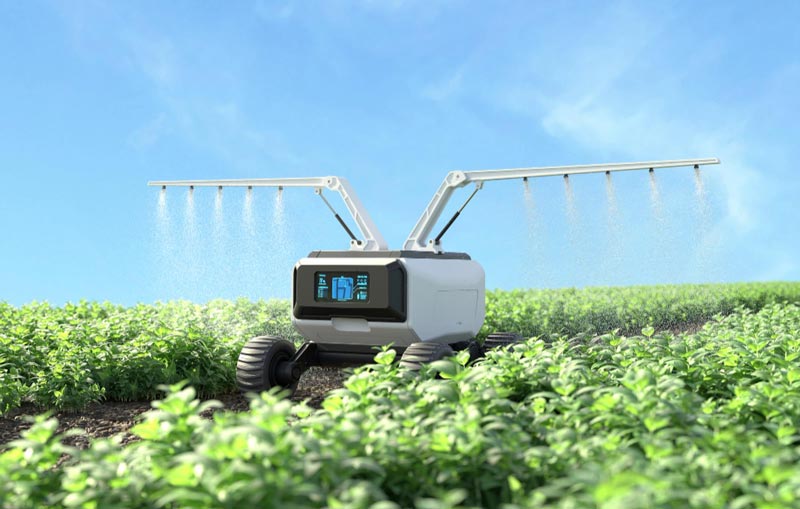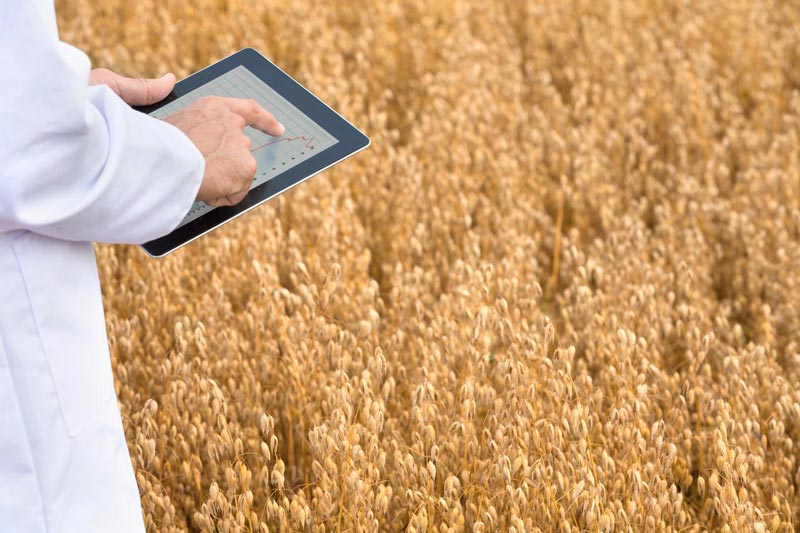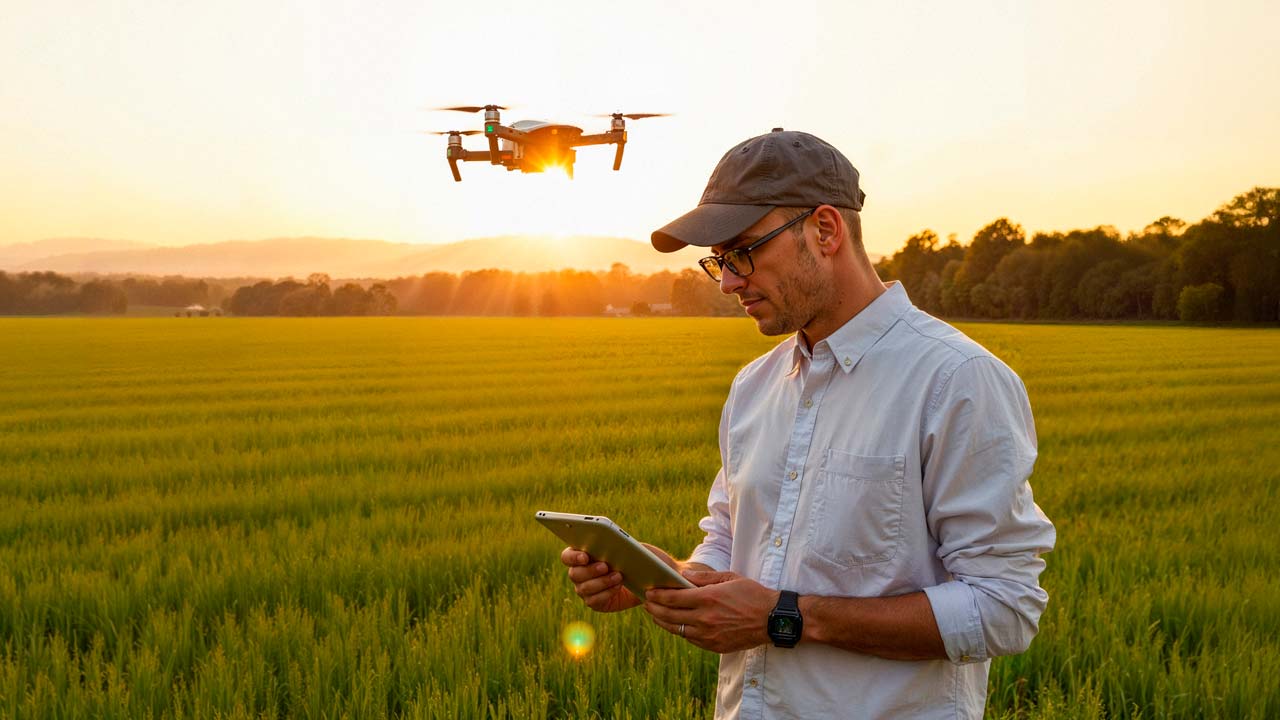Smart machinery and robotics applied to agriculture: Agriculture 4.0
Agriculture 4.0: The future
Modern agriculture is currently being redesigned by the impact of new digital technologies. Agriculture is experiencing a significant transformation thanks to the integration of advanced technologies such as robotics, the Internet of Things (IoT), artificial intelligence, and telecommunications, which are revolutionizing farms, greenhouses, and livestock operations throughout the country.
This technological revolution is no longer a promise for the future, but a growing reality: from autonomous tractors, drones that detect diseases before they are visible, and sensors that irrigate with surgical precision to technified vegetable gardens.
Agriculture faces the challenge—and opportunity—of leading this transition toward a more efficient, resilient, and sustainable agro-intelligent model. This evolution not only improves the profitability of farms, but also opens new doors for engineers, technicians, developers, and professionals in the digital sector, who find agriculture a fertile ground for innovation.
Smart machinery and robotics in agriculture are transforming the sector, improving farm efficiency and sustainability.
Smart agriculture technology is opening the door to a new era in farming, one in which technology and nature work together to achieve more efficient, sustainable, and resilient food production. As these innovations are implemented and mature, the farmers of the future will have powerful tools at their disposal that will transform the agri-food sector, not only in terms of productivity, but also in terms of its environmental and social impact.
This smart agricultural future is not just a distant vision, but a reality that is beginning to take shape, driven by technologies that are already revolutionizing the world. Smart agricultural engineering is not only the future of agriculture, but also the present that is building a new way to feed the world.
What do we mean by smart agricultural machinery?
Smart machinery is that which goes beyond its mechanical function and becomes an entity capable of perceiving, deciding, and acting autonomously or semi-autonomously. This transformation is possible thanks to the incorporation of sensors, embedded systems, and advanced connectivity, integrating mechatronic components, embedded software, advanced sensors, connectivity via mobile networks or LPWAN, and real-time control algorithms. The goal is to create autonomous and adaptive agricultural systems that improve resource efficiency and reduce direct human intervention.
Agriculture is undergoing a significant transformation thanks to the integration of advanced technologies in robotics, the Internet of Things (IoT), AI and telecommunications.
How a connected agricultural solution is built
It is useful to visualize the technical architecture of a connected agricultural solution to understand how this intelligence is implemented. It all starts with a network of sensors capable of capturing variables such as soil moisture, temperature, solar radiation, nutrient levels, or the presence of diseases. These sensors are connected to local processing systems (such as Raspberry Pi or STM32 microcontrollers) or remote systems in the cloud.
Decisions are made using algorithms hosted on these processors, or even in Edge Computing environments to reduce latency. In turn, actuators—such as valves, pumps, robotic arms, or drones—execute the corresponding instructions.

Communication between devices is established using technologies such as NB-Iot, LoRaWAN, and even 5G, depending on range, consumption, and latency requirements. The role of the IoT (Internet of Things) is fundamental: it connects the physical world with the digital world, allowing every element of the agricultural system to send and receive information continuously.
All of this is orchestrated by software platforms such as ROS (in robotics), SCADA (in automation) or customized dashboards that allow the farmer or technician to have total control from a mobile device.
Agricultural robotics: from the field to the data factory
Agricultural robotics is rapidly taking off with highly specialized solutions that automate tasks that previously required a large workforce.
Autonomous mobile robots
These robots are designed to move autonomously across agricultural terrain. Thanks to technologies such as SLAM (Simultaneous Localization and Mapping), artificial vision, LIDAR sensors, and high-precision GPS, they can cover large areas performing tasks such as monitoring, targeted irrigation, or mechanical weeding. They use frameworks like ROS 2 to manage their navigation and decision-making behavior.

This technological revolution is no longer a promise for the future, but a growing reality.
Robotic arms in agriculture
In controlled environments such as greenhouses, manipulative robotics is gaining ground. Robotic arms are capable of harvesting fruit with pinpoint accuracy without damaging it, pruning plants, or grafting with greater precision than humans. These systems integrate haptic sensors, stereoscopic cameras, and neural networks trained to recognize the exact point of intervention.
Swarms of collaborative robots
One of the most fascinating ideas is the use of swarms of small robots that work in a distributed manner, communicating with each other and with central stations. This approach improves the resilience of the system and allows operations to be scaled up in a modular fashion. It is a direct application of vehicle network concepts (V2V and V2I) adapted to the agricultural environment.
Telecommunications as the backbone of modern agriculture
Connectivity in rural areas has historically been a challenge, but new technologies are solving this bottleneck and enabling critical data to flow from the field to the cloud in real-time.
- LPWAN networks (such as LoRaWAN and Sigfox) enable the transmission of small amounts of data over long distances with minimal power consumption, ideal for soil sensors and weather stations.
- NB-IoT and LTE-M represent more robust options, with better integration into existing mobile networks, and enable the connectivity of more complex sensors, such as cameras or complete weather stations, with lower latency and greater reliability.
In the case of remote farms, drones and stratospheric balloons are being used as flying nodes to create temporary mesh networks or as mobile access points, facilitating connectivity in places where there is no fixed infrastructure.
Satellite technologies are also revolutionizing rural connectivity, enabling broadband access even in the most isolated areas.
■ The future is shaping up with 5G and 6G networks, which will open the door to ultra-connected agriculture, where latency is virtually eliminated and millions of devices can operate simultaneously, enabling large-scale automation and real-time decision-making.
Artificial Intelligence: the new digital agronomist
AI in agriculture is the cornerstone for turning data into useful decisions. Thanks to machine learning and massive data processing, it is possible to anticipate problems, optimize resources, and increase yields with surgical precision.
Through computer vision algorithms and convolutional neural networks (CNN), systems are able to detect diseases, assess the phenological status of plants, and automatically count fruits. Algorithms such as YOLO or Faster-RCNN enable the identification and classification of objects in high-resolution images taken by drones or ground cameras.
Predictive models also make it possible to anticipate yields, forecast irrigation or fertilization needs, and adapt crops to future weather conditions. This is achieved through techniques such as multivariate regression, Random Forest, deep neural networks, and time series analysis.

The rise of TinyML means that more and more agricultural sensors are incorporating intelligence directly at the edge, enabling immediate analysis and decisions without relying on the cloud. This is key for situations where connectivity is limited or intermittent.
AI also enables the creation of digital twins of crops, plots, or even entire farms, simulating behaviors and conditions to perform virtual tests before making physical decisions, saving resources and improving farm resilience.
Agricultural robotic systems combine specialized hardware (actuators, motors, cameras, multispectral sensors) with autonomous navigation and computer vision software. Their use allows repetitive or precision tasks to be delegated to machines capable of operating 24/7, minimizing human error and improving the traceability of each operation.
Automation: when the field manages itself
Automation transforms traditional agricultural operations into an autonomous system based on rules, learning, and real-time feedback.
From smart irrigation systems that regulate flow based on climate and soil data to machinery that operates in sync without human intervention, the field can be managed like a factory of data and actions.
Agro-intelligent engineering is opening the door to an era in agriculture where technology and nature work together to achieve more efficient, sustainable and resilient food production.
The integration of PLCs, industrial sensors, electric actuators, and human-machine interfaces (HMIs) allows for the construction of systems with SCADA architecture customized for agriculture. These systems are increasingly common in greenhouses, hydroponic systems, silos, and agricultural logistics centers.
Interoperability is key, which is why protocols such as MQTT (lightweight and efficient), OPC-UA (secure and industrial), and CAN-Bus (robust and widely adopted in machinery) are used. Thanks to this, different elements from different manufacturers can be integrated into a single coordinated ecosystem.
The concept of adaptive automation, driven by AI and edge computing, allows systems to learn from their environment and automatically adjust their parameters, continuously optimizing efficiency. This includes everything from dynamic fertilizer adjustment to the synchronization of harvesters and autonomous tractors across large areas of land.
Cyber security: the Achilles heel of digital agriculture
As more digital devices, systems, and platforms are integrated into the field, threats are also growing. Cyber security is therefore becoming a critical necessity, especially in environments where failure or sabotage can lead to massive economic losses or food risks.
Agricultural IoT devices are particularly vulnerable due to their limited processing capacity and deployment in open environments. To protect them, the use of encrypted communication protocols, multi-factor authentication, network-level firewalls, and secure firmware update mechanisms (OTA) is required.
SCADA and automation systems must be isolated through network segmentation, the use of VLANs, and the application of access control rules. Analytics platforms must have intrusion detection (IDS/IPS) and cloud backup systems with automatic recovery.
User and technician training is also vital. The security of digital agriculture depends not only on technology, but also on human practices: secure passwords, physical access control, and awareness of phishing attacks or internal sabotage.
■ AI is also being used as a shield: AI-based threat detection systems can identify anomalous behavior patterns and trigger automatic responses before an attack causes real damage.
Looking towards the future: agricultural engineering
The agriculture of the future will be a synergy between biology, data, and technology. We anticipate the arrival of 6G connectivity, brain-machine interfaces that could revolutionize remote monitoring, and the use of bio-inspired robotics adapted to agricultural terrain.
Quantum computing, still in its exploratory phase, promises to revolutionize weather forecasting and the modeling of complex agricultural systems, which would mark a turning point in the way food production is planned.
- 6G connectivity: the new era of digital agriculture
Although 5G is already enabling significant advances in agricultural connectivity, the 6G network promises to take smart agriculture to new levels. With even faster data transmission speeds and extremely low latency, 6G networks will enable agricultural systems to connect in real time on a much larger scale.
■ This will not only allow multiple devices and machines to communicate with each other but will also facilitate the integration of more advanced solutions, such as the coordination of autonomous robots in the field, the automation of irrigation and fertilization processes, and the implementation of advanced vision technologies to instantly detect pests or diseases. - Quantum computing: the power of advanced prediction
One of the most exciting areas that are emerging is quantum computing. This technology has the potential to revolutionize the way complex agricultural systems are predicted and managed. Thanks to its ability to process and analyze data at unparalleled speeds, quantum computing could significantly improve the accuracy of weather forecasts, optimize crop growth models, and even predict crop yields with unprecedented accuracy.
■ Farmers will be able to analyze large volumes of data more efficiently, allowing them to make much more informed decisions about when to plant, water, fertilize, and harvest, quickly adapting to changing weather conditions. - Bio-inspired robotics: adapting to the agricultural environment
Bio-inspired robotics is another key area that will shape the future of agro-intelligent engineering. Instead of creating rigid machines that are suited to a single type of task or environment, the robots of the future will be designed to be highly adaptable and capable of interacting with the agricultural environment in a natural way. These robots, inspired by the movements and behaviors of living beings, will be able to work together to perform tasks such as planting, crop monitoring, and harvesting, automatically adjusting to different terrain and weather conditions.
Instead of a massive tractor covering large areas of land, for example, smaller, more agile robots will be able to navigate between rows of crops, acting individually or in swarms, and performing tasks such as pest control or fertilizer application in very specific areas, with minimal environmental impact.
■ This approach will optimize resource use, reduce waste, and minimize the use of chemicals, making agriculture more environmentally friendly. - Brain-machine interfaces: the future of remote monitoring
Advanced connectivity, combined with brain-machine interfaces (BCIs), could change the way farmers manage their farms. These interfaces will allow operators to monitor and control agricultural systems remotely by simply thinking about the actions they want to perform, eliminating the need for physical devices and offering an even more precise level of control.
■ This could facilitate remote supervision and control of agricultural machinery and robots, improving efficiency and reducing human intervention in dangerous or difficult-to-access terrain. - Sustainability and efficiency in the agriculture of the future
The future of agro-intelligent engineering is also closely linked to sustainability. As the world's population continues to grow and demand for food increases, emerging technologies will need to enable more efficient and environmentally friendly agricultural production. Innovations in resource management, such as the use of drones to monitor crop health or the automation of irrigation systems based on moisture sensors and weather forecasts, will enable farmers to optimize the use of water, fertilizers, and other inputs.
■ This will not only reduce costs but also minimize the environmental impact of agriculture, helping to combat desertification and the depletion of natural resources. - The biotechnology revolution
Along with agro-smart engineering, biotechnology will play a crucial role in the agriculture of the future. Advanced genetic technologies will enable the development of crops that are more resistant to disease, pests, and extreme weather conditions. Advances in gene editing and crop engineering will also offer opportunities to improve food yield and quality while reducing inputs and increasing biodiversity.
■ This will not only benefit agricultural productivity but also improve food security in regions facing environmental or economic challenges.
The goal is to create autonomous and adaptive agricultural systems that improve resource use efficiency and reduce direct human intervention.
Agriculture 4.0: a new field for engineers
Engineering and telecommunications are not only relevant in the field: they play a leading role in its transformation. From sensor design to the implementation of networks and AI algorithms, telecommunications engineers and computer engineers have and will continue to have a major role in applying their knowledge to a vital and constantly evolving sector such as agriculture.
Smart agriculture is not a trend; it is here to stay. It is a necessity and an opportunity to innovate with a real impact on the sustainability of the planet.
Technical bibliography
● FAO. (2023). Digital agriculture: Farmers in the driver’s seat.
● IEEE Spectrum. (2022). Precision Agriculture and Smart Farming Technologies.
● Blue River Technology.
● Naïo Technologies.
● Agrobot.
● ITU. (2021). Harnessing Telecom and AI for Smart Agriculture.
Opening imagen: Freepik.
 Hybrid Cloud
Hybrid Cloud Cyber Security & NaaS
Cyber Security & NaaS AI & Data
AI & Data IoT & Connectivity
IoT & Connectivity Business Applications
Business Applications Intelligent Workplace
Intelligent Workplace Consulting & Professional Services
Consulting & Professional Services Small Medium Enterprise
Small Medium Enterprise Health and Social Care
Health and Social Care Industry
Industry Retail
Retail Tourism and Leisure
Tourism and Leisure Transport & Logistics
Transport & Logistics Energy & Utilities
Energy & Utilities Banking and Finance
Banking and Finance Sports
Sports Smart Cities
Smart Cities





